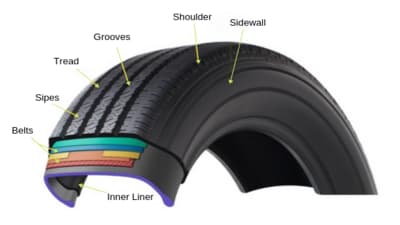Parts Of A Tyre
It’s important to understand how tyres work so that you can adequately assess whether your tyres are safe to drive. Understanding the different parts of a tyre will also help you when it comes to speaking to mechanics, as you can use the correct terms to locate the problem. Tyre safety is an incredibly important factor when it comes to running your car, so knowing your tyres can help you to stop any disasters before they occur.

Inner liner
The inner liner of a tyre is made from a rubber sheet that results in low air permeability. This helps the tyre to hold high pressure air inside, whilst also minimising the amount of air that is diffused through the rubber structure.
Tyre belts
These are steel belts made from woven wire sheets, placed around the surface area of the tyre to provide rigidity and reinforce its strength. Sometimes, manufacturers add a Kevlar cord, making sure the tyre is even stronger – in order to increase durability and make the tyre puncture resistant.
Tyre sipes
Sipes are small grooves that are cut across larger parts of the tread. It will often look like a small slit in the tire’s tread block, and it will create an additional tread surface area for increased grip in wet, icy and snowy conditions.
Tyre tread
Tyre treads often have different patterns. As the only area where the tyre makes contact with the road, the tyre tread will provide grip and cushioning for the car, depending on the design and compound selected. Because of this, the tyre tread is one of the most important safety features on the car – this why winter tyres will usually have much deeper and wider tread than normal tyres.
Tyre grooves
Grooves are part of the tyre’s tread. Deeper than sipes, tyre grooves act to disperse water, ice, snow and mud, ensuring that a car can move safely on the roads in all conditions. This expels water from beneath the tyre to prevent aquaplaning.
Tyre shoulder
The shoulder of the tyre offers support and protection to the sidewall and tread of the tyre, and as one of the thickest parts of the tyre, it allows tyres to hold their form whilst drivers take the vehicle around corners and turns.
Tyre sidewall
The sidewall is one of the most commonly known components of a tyre. It has extra thick rubber running from the bead to the tread, to make the tyre laterally stable. This is also where manufacturers put information about the tyre, so it is a good point of reference when looking for the tyre pressure or what size tyre to buy.
Tyre ply
The tyre’s skeleton is made up of layers of fabric, often called the ply. The fabric’s cord fibres are woven together and coated with rubber, and the ply is placed above the inner lining of the tyre, strengthening the structure.
Beads
Ultra-strong steel coated rubbers are called the beads and form an airtight seal between the tyre and the wheel rim.
05 Nov 2019
Did you enjoy this blog post?
|
27 people found this review helpful
